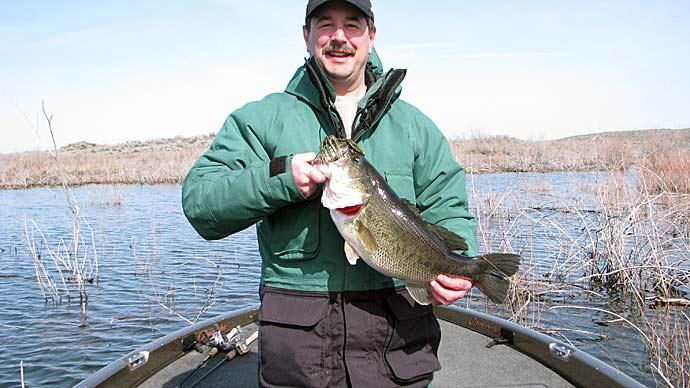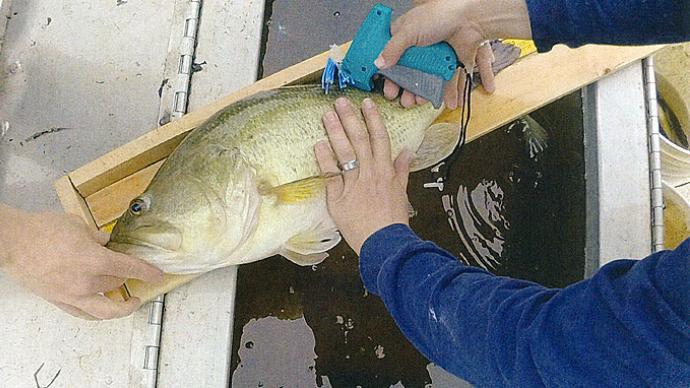
Thanks to plenty of sunshine and warm seasons, the southeastern United States is prime ground for producing trophy Largemouth bass. Well-managed waters in this part of the country naturally produce thriving populations of forage over a long season. This fuels ideal conditions for Largemouth bass to become spoiled, fat, and happy...our goal.
Capitalizing on the opportunity to create a fun fishery of this nature brings excitement to landowners blessed with enough resources.
In 2015, a landowner with a 10-acre lake set his eyes on creating a trophy fishery with double-digit bass. He knew he would need an abundant forage base and good bass genetics to do things properly. Although he was not up to speed on the most advanced management strategies, he hired fisheries professionals to help him accomplish his goals.
Over the course of the fishery's first few years under management, the owner and the biologists made some excellent decisions. First and foremost was resetting the fishery.
This management strategy provides significantly better odds of producing double-digit bass. During the resetting process, the lake was drained, cleaned up, and deepened in areas, improving both depth and the bottom contour. Add some habitat, and this lake was ready for water.
Once the lake filled, biologists introduced bluegill, redear sunfish, golden shiners, fathead minnows, and threadfin shad. They installed bottom-diffused aeration to improve water quality and placed artificial fish structures to improve angling experiences. They installed three fish feeders and implemented a fertilization program to boost forage production. Then, in the summer of 2016, they stocked F1 strain Largemouth bass fingerlings at a rate of 25 per acre, totaling 250 fish.
Over the years, biologists conducted electrofishing assessments and made adjustments as needed. As the bass grew larger, they also incorporated gizzard shad and rainbow trout into the management strategy to provide a larger meal to the bass. Although bass were growing larger, the owner grew concerned his initial generation of Fl's were not reaching their full potential. More concerning, however, was that the fishery appeared to lack a second or third-generation of bass growing fast enough to reach his double-digit goals.

The fishery had some excellent fish, but electrofishing data collected in the spring of 2020 supported his concerns. Only four bass greater than four pounds were collected that spring, with 85 percent of the bass weighing less than three pounds. The sample size was sufficient, but the quality of the pre-spawn bass needed to be improved. Eventually, he decided to make a change and bring a fresh set of eyes to the project.
In that process, he hired SOLitude.
As with all trophy bass fisheries, some management improvements are apparent, while others take time to figure out. Upon getting to know the fishery in the late summer and fall of 2020, a few adjustments made sense immediately.
First, it was clear the fishery had too many bass, which suppressed growth rates for all bass and led to depleted forage base populations. Instead of applying rotenone and resetting the fishery, the landowner and SOLitude chose to overhaul the existing bass population using a combination of electrofishing and angling. A goal was set to reduce the population to 200 female bass and then stock a new generation of fast-growing female Titan F1 Largemouth bass once the undesired bass were harvested-bringing the estimated bass population to 250 fish. This population target was intended to be a fluid number that may increase or decrease in future years but, for the time being, would serve as a benchmark in improving bass growth rates while also re-establishing a more robust forage population.
Restructuring a bass population in a lake this size, using electrofishing and angling, typically takes 24 months. However, it's realistic to do it in 12 months if the waterbody's habitat is outstanding and efforts are robust.
This involves selecting the female bass you want to remain in the waterbody while harvesting all other bass.
Although this fishery would not exceed expectations for several years, it was still capable of producing measurable results. The initial generation of Fl's stocked in 2016 were good fish and had a chance of reaching double digits, but not likely until they are dying of old age. Although imperfect, these big bass will provide great fishing opportunities as the owner patiently awaits more sustainable future generations of fast-growing bass.
The most significant error made in the original management strategy was to allow the bass population to become overpopulated. Based on the lofty bass growth goals and the owner's avid fishing experience, it is realistic to say that male bass should have never been introduced into the system following the initial reset. Male bass are inferior to females in top-end growth. So, based on the double-digit growth goals, male bass make little sense. To compound matters, the offspring of Fl's are considered genetically inferior to their F1 parents, resulting in less favorable bass in fisheries intended for top-end growth. If looking to create a sustainable fishery capable of producing double-digit bass within each generation, the strategy should not lean on offspring from Fl's to accomplish the objective. A more favorable solution would be all female Fls, as well as layering in pure Florida female bass at least every other year. Given the geographical location of the waterbody, it is not guaranteed that pure Florida bass will always survive winter. If the owner were to balance the risk/reward of Florida genetics, they would want to consider no more than 1/3-1/2 of the population being pure Florida strain.
While harvesting bass, it became apparent that the fishery lacked sufficient cover. The lake lacked adequate vegetation, wood, and rock. It did have some artificial cover, but it was spaced out too much and difficult to locate. Bass failed to associate with these areas very well due to a lack of cover, making electrofishing and angling efforts less efficient than desired. Fish were dispersed rather than concentrated
This poor cover scenario made assessing the fish population and harvesting bass more complicated than it needed to be. This was especially true when estimating how many bass were in the system. Following fish collection struggles, logs were installed in the pond to better congregate bass. Unfortunately, due to the scarcity of wood in 2021, the log installation was delayed until the summer of 2022. In addition to adding woody cover, aquatic vegetation was installed in both 2021 and 2022 to improve the complexity of the fish habitat.
The spring of 2023 will mark 24 months of effort toward restructuring the bass population. Although the bass population was not entirely restructured in 2022, nearly zero bass recruitment was observed during the fall 2022 electrofishing study, indicating the fishery was nearing its goal. Lack of recruitment indicates that the male bass population is becoming depleted simultaneously as the biomass of forage fish is increasing. Momentum is building in a positive direction. The forage base needs more momentum, and the bass population needs an additional round of harvesting.
Water quality was another critical variable that impeded the fishery's success. During heavy rainstorms, incoming runoff would turn the entire pond brown with sediment, disrupting the plankton bloom and negatively impacting the forage base. Further examination of the watershed revealed areas of exposed soil and erosion. The most significant contributor was a large ditch that ran several hundred yards in a straight line, allowing water to run rapidly downhill. Using riprap, small check dams were installed to slow the water down, significantly reducing erosion. Although they have much work to install, they have done a great job minimizing sediment-related turbidity following heavy rainfall.
Another water quality challenge for the fishery is the extensive shallow water. Around 60 percent of the waterbody is 5 feet deep or less, with a max depth of around eight feet. In the summer, this shallow water can reach temperatures in the high 80s and low 90s, reducing areas for bass to find cool-water refuge. Although this variable is difficult to manipulate or improve, it sure can harm bass growth and prevent them from reaching their maximum growth potential. This emphasizes the importance of minimizing as many other limiting factors as possible.
The management adjustments made over the past two years will have a profound effect on the fishery's trajectory. The forage base still has room for improvement when managing to high standards, but overall, it has rebounded noticeably well. The initial generation of Fl's continues to grow, as they should. When electrofishing in the spring of 2022, two egged-up six-year-old females tipped the scales at seven pounds and are on their way to meeting the owner's expectations. With another year of hard work and strategic management efforts ahead, this fishery will likely be fully on track by late fall 2023.
David Beasley is a Fisheries Biologist and the Director of Fisheries at SOLitude Lake Management, an environmental firm providing sustainable lake, pond, wetland, and fisheries management services. Learn more about this topic at www.solitudelakemanagement.com/knowledge
Reprinted with permission from Pond Boss Magazine



